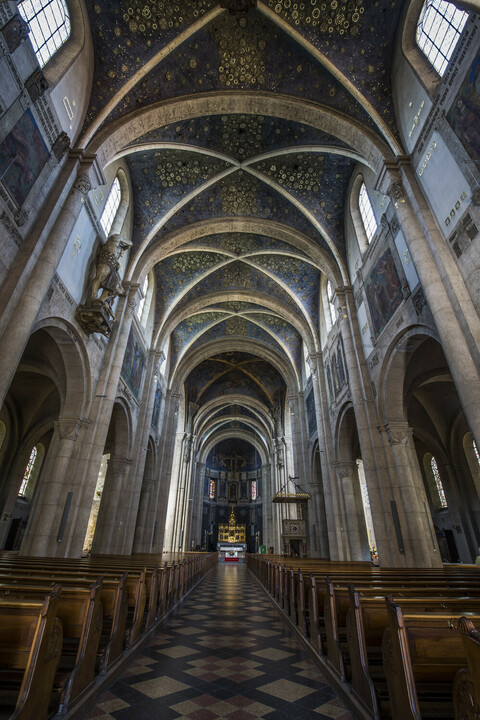Interior decoration in Jugendstil

It’s hardly surprising that it took 14 years to decorate the Catholic church of St. Josef’s, which stands in the heart of Weiden. The opulence of the building, which was created in Jugendstil over a hundred years ago, is stunning. There is always something new to discover on the pillars, walls, and ceiling. The paintings show scenes ranging from the rootedness of faith in our native country (pictures of messengers of the faith on the walls of the transept) back to the first narratives of Holy Scripture with the various stories of the Creation. People of today are not very conscious of the notion that the world has actually been entrusted to human beings as a garden where they are supposed to feel good (painting of Adam and Eve in paradise directly to the right of the left side altar), and that all of life is a gift, God’s creation (Adam is brought to life by the breath of God, relief above the entrance from the sanctuary to the sacrament chapel directly to the left of the left side altar). The sanctuary provides an opportunity to reflect on this gift of creation in peace and to internalize to a greater extent that this gift brings responsibility with it: the responsibility to treat the valuable thing entrusted to me in such a way that I can then pass it on to subsequent generations.
Ancient Egyptian art in the depiction of animals
Plants and animals are popular motifs in St. Josef’s. The artist Hofstötter, who was responsible for the interior decoration of the church, was familiar with Ancient Egyptian art and, of course, with many of the depictions in the Bible. An entire zoo of animals, some more exotic, some less so, stems from these two sources. There is a particularly large number of animals gathered in the front section of the church. Let’s just take the example of the first section of the vault that comes after the apse: this accommodates a wolf, a lamb, a lion, and a bear. The depictions refer to the peaceful nature of Paradise, which the prophet Isaiah described thus: “The wolf will live with the lamb; the leopard will lie down with the young goat. The calf and the lion will graze together”. Although it is present in a completely different way now, there is also the desire today for all living creatures to live together in harmony. The following creatures are assembled in the subsequent section: a stag, a pelican, a peacock, and a phoenix. The pictures, reliefs, and sculptures which depict Bible scenes throughout the sanctuary show many plants and animals from the Middle East. The lion in the story of Samson, for example, is particularly striking. If you look up shortly before you walk under the gallery, you can see it in the right side aisle.
Jugendstil in depictions of fantasy plants
Aside from animals and plants as symbols and motifs, representations of nature have forged their way into the entrance of St. Josef’s in another way too: Jugendstil had a predilection for them as ornaments for emphasizing and underlining the mystical, secretive, splendid, and dignified character of the space. So there are fantasy plants and animals like fish, lizards, monkeys, and dogs in every nook and cranny that you would never expect to find here. God sleeps in the stone, He breathes in the plant, He dreams in the animal, and awakens in the human being.
More information on St. Josef's
Address of St. Josef's and rectory
St. Josef's
Bürgermeister-Prechtl-Str. 13, 92637 Weiden in der Oberpfalz
Rectory St. Josef's
Bürgermeister-Prechtl-Str. 15, 92637 Weiden in der Oberpfalz
Tel.: 0961-390830




![[Translate to Englisch:] Jugendstilkirche St. Josef](/fileadmin/_processed_/a/a/csm_St._Josef_Jugendstilkirche_in_Weiden_24aad8a368.jpg)
 weiden.de
weiden.de
Data privacy Liability Legal notice